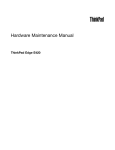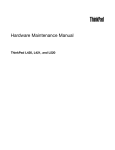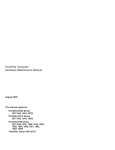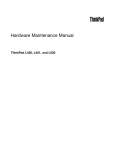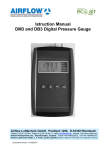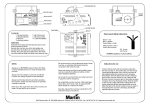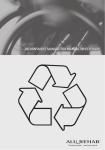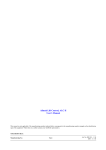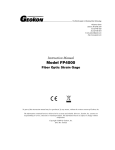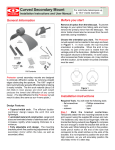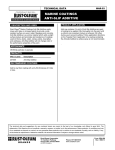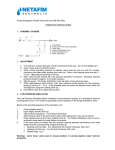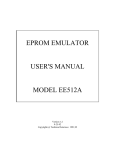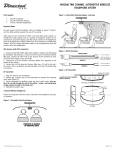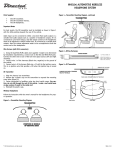Download Contents 1 Preface 3 2 Introduction 3 3 Safety
Transcript
Shipham Valves Hawthorn Avenue, Hull, HU3 5JX, United Kingdom Tel +44 (0)1482 323163 Fax +44 (0)1482 224057 web: http://www.shipham-valves.com email: [email protected] OPERATING AND MAINTENANCE INSTUCTIONS OMI 12.2 Revision 01 Date: 8 July 2008 This revision supersedes all previous revisions Contents 1 Preface 3 2 Introduction 3 3 Safety Precautions 3 4 Valve Description 4 4.1 General 4.2 Butterfly Valve 4.3 Valve Characteristics 4 4 4 5 Handling and Storage 5 5.1 Handling 5.2 Storage 5 5 6 Installation 5 6.1 Inspection Prior to Installation 6.2 Installation 6.3 Testing 5 5 6 7 Operation 6 8. Maintenance 6 8.1 Routine (Scheduled) Maintenance 8.2 Breakdown Maintenance 8.2.1 General - Leak via the Flange 8.2.2 Butterfly Valve - Not Sealing Correctly When Closed 8.2.3 Butterfly Valve - Shaft Leak 6 6 6 7 8 9 Spare Parts 10 9.1 For 2 Piece Taper Shaft Butterfly Valves 9.2 For 1 Piece Parallel Shaft Butterfly Valves If in doubt please contact Shipham Valves Page 1 of 9 10 10 Shipham Valves Hawthorn Avenue, Hull, HU3 5JX, United Kingdom Tel +44 (0)1482 323163 Fax +44 (0)1482 224057 web: http://www.shipham-valves.com email: [email protected] OPERATING AND MAINTENANCE INSTUCTIONS OMI 12.2 Revision 01 Date: 8 July 2008 This revision supersedes all previous revisions DESCRIPTION THIS COVERS AVT BUTTERFLY VALVE RANGE PREFACE This document is a manual for ball and butterfly valves, it is intended for system engineers and users. For instructions regarding the actuation devices, see the actuator user manual. When mounted in a pipeline system in Europe, the valve / actuator unit may become a component on which the European directives are applicable. The end user and system engineer shall complete the certification procedure for the CE marking if applicable. INTRODUCTION This manual gives instructions for the system engineer and end user regarding the installation and use of the butterfly and ball valves in flanged pressurised piping systems. This manual shall be reviewed in detail prior to handling and installation and kept in the documentation file for future reference. It is therefore recommended that these maintenance instructions are incorporated into the total system maintenance instructions. The valves are intended as isolation valves, they may under certain circumstances be used as a control valve depending on the process and having an appropriate actuator fitted. The ball valves are suitable for bidirectional flow however the butterfly valves have a preferred direction and must be installed in the correct orientation; the body of the butterfly valve indicates the preferred direction. The valve materials used in the body, shaft and seat components are selected based on anticipated system conditions; they must be chemically and physically compatible with the line fluids, rinsing fluids and other connecting pipe components. SAFETY PRECAUTIONS Follow carefully all instructions in this manual with respect to handling, installation, operation and maintenance. Not observing the recommendations and cautions in this manual will decrease the assurance of safe and satisfactory valve performance. When the valves are used in a hazardous location, all electric components (e.g. solenoids, actuators) shall comply with the relevant or application standard relating to the hazard. Do not operate the valve with system pressures higher than allowable for the valve. Do not operate the valve with system temperatures lower or higher than allowable for the valve. Do not operate the valve with system fluids other than those specified for use with the valve. If in doubt please contact Shipham Valves Page 2 of 9 Shipham Valves Hawthorn Avenue, Hull, HU3 5JX, United Kingdom Tel +44 (0)1482 323163 Fax +44 (0)1482 224057 web: http://www.shipham-valves.com email: [email protected] OPERATING AND MAINTENANCE INSTUCTIONS OMI 12.2 Revision 01 Date: 8 July 2008 This revision supersedes all previous revisions Only appropriately qualified and competent personnel are to place into operation, operate, withdraw from operation and maintain the valves and components supplied under this contract. Inappropriate installation, use and maintenance will invalidate the warranty. On actuated valves there is the potential of stored energy in the form of springs, electric, pneumatic or hydraulic; therefore care must be taken that the energy is release or removed in a controlled manor. Always avoid contact with the ball or disc when it may cycle. Take the necessary precautions when handling large valves and valve components. VALVE DECSRIPTION 4.1 General The valve body is manufactured from a composite weight, strong and corrosion resistant. The body of designed as a pressure containing part, it has been above the normal working (rated) pressure. The body for mounting between pipe flanges. material that is light the valve has been tested to a pressure has end connections 4.2 Butterfly Valve The body has two apertures for securing the single shaft, the shaft extends out from the body and is used to operate the disc by the actuation device. The disc is circular device that can rotate on the axis of the shaft by approximately 90˚ the sealing of the valve is performed when the valve disc is perpendicular to the pipeline, this is ultimately achieved by an elastomer material on the outer edge of the disc mating with the fixed valve seat on the body of the valve. When the valve disc is parallel to the pipeline the valve is fully open. The end of the valve shaft indicated the disc orientation. 4.3 Valve Characteristics The valve test certificate, supplied with the valve, details the specific valve characteristics. The valve is designed and tested for a maximum working pressure. The valve components are selected to withstand the minimum and maximum service temperature, component selection takes account of the process fluid that the valve will be exposed to. If in doubt please contact Shipham Valves Page 3 of 9 Shipham Valves Hawthorn Avenue, Hull, HU3 5JX, United Kingdom Tel +44 (0)1482 323163 Fax +44 (0)1482 224057 web: http://www.shipham-valves.com email: [email protected] OPERATING AND MAINTENANCE INSTUCTIONS OMI 12.2 Revision 01 Date: 8 July 2008 This revision supersedes all previous revisions INSTALLATION The valve shall be properly inspected and installed. 6.1 Inspection Prior to Installation • Carefully unpack the valve • Inspect the valve visually for damage during transport, handling and storage • Check the identification plate attached to the side of the valve correctly fulfils the intended application requirements • Check the valve interior is clean, free of foreign matter and damage • If practical actuate the valve through open and closed cycles, check that the valve functions smoothly and correctly (avoid contact with the ball/disc when cycling the valve) Immediately prior to installation, check that the flanges to which the valve is to be fastened are parallel, are set apart the correct distance and will not cause the valve to be placed under stress, are without burrs, free from oil or other contaminants. 6.2 Installation • The valve is designed to be installed with gaskets, the selection of these should take account of the pipeline size and process fluid, pressure and temperature • Take account of the flow direction if the valve is mono directional • The orientation of the valve within the pipe line is not important • Make sure that the valve is located were it can be operated, maintained and inspected • Check that the valve fixings to be used are the correct length, size and are suitable for the environmental conditions. • It is important to use washers of the correct size • Offer the valve into position and secure • Tighten the bolts/studding in the correct tightening sequence and to the correct torque as indicated in the data supplied with the valve 6.3 Testing • If possible flush the line with a compatible rinsing liquid • Open and close the valve to ensure that there is no interference • Connect the actuator (if applicable) according to the actuators installation information Warning: A system test at a pressure higher that the working pressure shall only be performed with the valve in the open position. It is recommended that pressure testing only be undertaken with water and taking into account all safety precautions If in doubt please contact Shipham Valves Page 4 of 9 Shipham Valves Hawthorn Avenue, Hull, HU3 5JX, United Kingdom Tel +44 (0)1482 323163 Fax +44 (0)1482 224057 web: http://www.shipham-valves.com email: [email protected] OPERATING AND MAINTENANCE INSTUCTIONS OMI 12.2 Revision 01 Date: 8 July 2008 This revision supersedes all previous revisions OPERATION Check for smooth operation. In high volume liquid flow when closing the valve, do not close the valve too quickly as this may induce a pressure surge (water-hammer). MAINTENANCE 8.1 Routine (Scheduled) Maintenance It is recommended to schedule a periodic partial or full cycle of exercising of valves which remain in either the open or closed position for long periods of time. • Check for smooth operation • Check for leaks from the flanges and valve stem • On ball valves, leaks from the valve stem can be stopped by tightening the chevron packing on to the stem using the gland packing plate adjustment, each nut should be tightened equally until the gland stops leaking 8.2 Breakdown Maintenance 8.2.1 General - Leak via the Flange Cause: Valve not being centred in the pipe centreline Solution: - Remove the valve actuating mechanism - Remove valve from pipeline check flanges for damage, repair if necessary. - Inspect gaskets for damage, replace if necessary - Install valve in accordance to the installation instructions supplied with the valve - Reconnect the valve actuator Cause: Valve and pipeline flange dimensions incompatible Solution: - Remove the valve actuating mechanism - Remove valve from pipeline - Mount flanges with the correct sealing area. - Inspect gaskets for damage, replace if necessary - Install valve in accordance to the installation instructions supplied with the valve - Reconnect the valve actuator 8.2.2 Butterfly Valve – Not Sealing Correctly When Closed Cause: Damage of the sealing area by foreign parts Solution: - Remove the valve actuating mechanism - Remove valve from pipeline, inspect sealing area for damage - Repair minor damage by dressing valve seat and disc seal using fine abrasive paper or an abrasive block (no coarser than 120 grit, finish with 400 grit), more extensive damage will require valve replacement. If in doubt please contact Shipham Valves Page 5 of 9 Shipham Valves Hawthorn Avenue, Hull, HU3 5JX, United Kingdom Tel +44 (0)1482 323163 Fax +44 (0)1482 224057 web: http://www.shipham-valves.com email: [email protected] OPERATING AND MAINTENANCE INSTUCTIONS OMI 12.2 Revision 01 Date: 8 July 2008 This revision supersedes all previous revisions - Install valve in accordance to the installation instructions supplied with the valve Reconnect the valve actuator Cause: Wear of sealing surface Solution: - Remove the valve actuating mechanism - Remove valve from pipeline - It is recommended to replace entire valve. - Install valve in accordance to the installation instructions supplied with the valve - Reconnect the valve actuator Cause: Actuator incorrectly adjusted Solution: - Check that the disc is stopping at 90˚ - Adjust actuator (see actuator manufactures installation information) Cause: Incorrectly adjusted closure limit stop Solution: - Remove the valve actuating mechanism - Remove valve from pipeline - Close the valve - Insert and tighten a short socket head screw into the end of the eccentric cam pin - Loosen the cam locking grub screw, accessed via the treaded hole in the end of the shaft - Rotate the cam pin away from the stop face - Close the valve fully to the point that the flat of the disc is parallel with the face of the valve body - Rotate the cam pin until it comes into contact with the stop face - Tighten the locking grub screw - Remove the short socket head screw from the end of the eccentric pin - Open and close the valve and retest for parallelism - If required make further adjustments following the previous steps - Install valve in accordance to the installation instructions supplied with the valve - Reconnect the valve actuator If in doubt please contact Shipham Valves Page 6 of 9 Shipham Valves Hawthorn Avenue, Hull, HU3 5JX, United Kingdom Tel +44 (0)1482 323163 Fax +44 (0)1482 224057 web: http://www.shipham-valves.com email: [email protected] OPERATING AND MAINTENANCE INSTUCTIONS OMI 12.2 Revision 01 Date: 8 July 2008 This revision supersedes all previous revisions 8.2.3 Butterfly Valve – Shaft Leak Cause: Shaft seal is worn, aged or damage Solution: (for 2 piece taper shaft) - Remove the valve actuating mechanism - Remove valve from pipeline - Remove the resin plug from the bottom of the valve (this is lightly glued in place and is sacrificial. - Remove bolt and corresponding washer from bottom of the shaft - Set the disc to the open position - Insert a drift through the screw hole, taking care not to damage the tread lightly tap out the shaft - Insert a drift in the main shaft aperture and lightly tap out the lower shaft sleeve - Remove the disc and spacers that are located either side of the disc - Replace the failed components, if appropriate the use of silicone grease will ease assembly of the elastomer o rings and shaft seals Insert the lower shaft sleeve - Assemble the valve disc with spacers either side on to the valve body (note the taper hole in the disc is correctly oriented to accept shaft assembly) - Slide shaft into valve body, spacer, disc, spacer and then into lower shaft sleeve (note the flat on the shaft will be facing the curved face of the disc) - Insert the bolt and corresponding washer from bottom of the shaft and hand tighten, finally, gently tap the shaft whilst hand tightening, this will be sufficient force to correctly assemble the valve - Insert a new resin plug into the bottom of the valve and secure using isocyanate glue - If a new disc assembly has been used it will be necessary to adjust the closure limit stop as detailed above. - Install valve in accordance to the installation instructions supplied with the valve - Reconnect the valve actuator Solution: (for 1 piece parallel shaft) Note: For specialist applications (acids, caustics, solvents, etc) it is important that the valve be replaced or returned to AVT for refurbishment. - Remove the valve actuating mechanism - Remove valve from pipeline - Remove the resin plug from the bottom of the valve (this is lightly glued in place and is sacrificial. - Remove screw and corresponding washer (if applicable PTFE washer) from bottom of the shaft - If disc locking pins have been used it will be necessary to use a 12mm masonry drill to remove the Epoxy material sealing the pins and drive out the securing pins from the flat face of the disc. If in doubt please contact Shipham Valves Page 7 of 9 Shipham Valves Hawthorn Avenue, Hull, HU3 5JX, United Kingdom Tel +44 (0)1482 323163 Fax +44 (0)1482 224057 web: http://www.shipham-valves.com email: [email protected] OPERATING AND MAINTENANCE INSTUCTIONS OMI 12.2 Revision 01 Date: 8 July 2008 This revision supersedes all previous revisions - - - - Set the disc to the open position Carefully hammer out the shaft or using a hydraulic press and suitable mandrel screwed into the lower end of the shaft, push out the shaft from the valve Remove the disc Remove the disc and spacers that are located are either side of the disc Clean any resin reside from the shaft Remove remaining pin sections Replace the failed components, if appropriate the use of silicone grease will ease assembly of the elastomer o rings and shaft seals Using a small amount of Devcon titanium loaded epoxy resin, in a ratio of 4.3 parts of resin to 1 part of hardener by weight, lightly coat the short tapered section of the shaft Assemble the valve disc with spacers either side on to the valve body Slide shaft into valve body, spacer, disc and spacer, tap home gently Insert and corresponding washer from bottom of the shaft and hand tighten Allow the epoxy to cure for a minimum of 1 hour Press / lightly tap in replacement pins so that they are sub flush with the disc by a minimum of 5 mm Create a header tank around one of the disk hole, using blue-tack or similar and fill with Araldite 2014 epoxy resin until the resin floods from the second hole. Note: it is important to coat the shaft with mould release to enable disassembly at a later date Allow the epoxy to cure for a minimum of 16 hours Remove excess epoxy Insert a new resin plug into the bottom of the valve and secure using isocyanate glue If a new disc assembly has been used it will be necessary to adjust the closure limit stop as detailed above. Install valve in accordance to the installation instructions supplied with the valve Reconnect the valve actuator If in doubt please contact Shipham Valves Page 8 of 9 Shipham Valves Hawthorn Avenue, Hull, HU3 5JX, United Kingdom Tel +44 (0)1482 323163 Fax +44 (0)1482 224057 web: http://www.shipham-valves.com email: [email protected] OPERATING AND MAINTENANCE INSTUCTIONS OMI 12.2 Revision 01 Date: 8 July 2008 This revision supersedes all previous revisions SPARE PARTS For general operating conditions no spare parts are required. For heavy duty (erosion, high frequency cycling) the following spare parts are recommended for spares holding. 9.1 For 2 Piece Taper Shaft Butterfly Valves Shaft seal (2 per valve) Small o ring (2 per valve) Large o ring (5 per valve) Thrust washer (2 per valve) 9.2 For 1 Piece Parallel Shaft Butterfly Valves Small shaft seal (1 per valve) Large shaft seal (1 per valve) Small o ring (2 per valve) Large o ring (3 per valve) Thrust washer (2 per valve) Locking pin (2 per valve) Devcon Titanium loaded epoxy resin Araldite 2014 DISCLAIMER While Shipham Valves has taken all reasonable care to ensure the information contained herein is accurate, this document is provided “as is” and Shipham Valves makes no warranty no warranty of any kind with respect to accuracy of the information. Shipham Valves cannot be held responsible for normal wear and tear, any improper installation, use maintenance or storage; negligence of the owner or user, unauthorised repair or modification after delivery, failure to follow instructions or recommendations or anything else beyond our control. Shipham Valves reserve the right to amend the information without notice. If in doubt please contact Shipham Valves Page 9 of 9









